What are the ways of tying radiators
One of the steps of designing a heating system is a way to connect batteries to it or to tie them. Thus, it is possible to increase the efficiency of its work and make the operation of heaters more comfortable. For example, tying heating radiators with polypropylene makes it possible to regulate their heat transfer, and in the case of emergency, repair or maintenance work, they can be quickly disconnected from the pipeline.
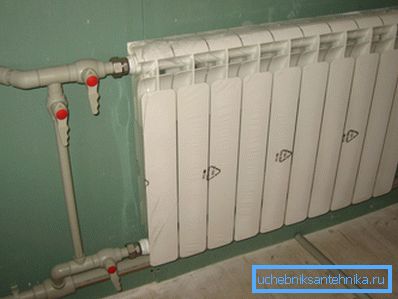
What to look for
We recommend to select in advance the types of registers, as well as their configuration, in order to create a heating system in accordance with the developed project.
In addition to them, it should include:
- boiler;
- pipelines;
- shut-off and control valves;
- pump (if necessary).
The installation process of heating devices is not particularly difficult:
- select in advance a place for heating devices according to the project;
- lead them to the pipeline or pipelines;
- Connect the battery and trunk pipes with your own hands.

Polypropylene pipe connection
Below we will consider the process of connecting heaters to the heating system, where PP pipes are used, the price of which today is one of the lowest.
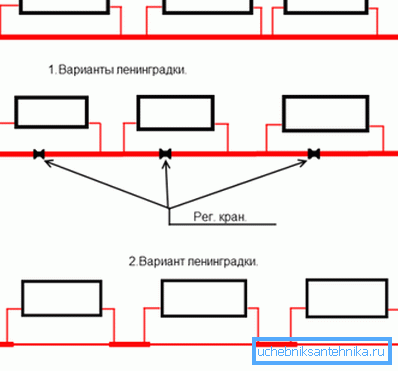
Currently there are two ways:
| Monotube or Leningradka | In this case, the coolant, most often water, immediately flows into the entire building, flowing down from the top through pipes installed in separate apartments. Such a system is often used in apartment buildings. Consider its disadvantages:
|
| Twin tube |
|
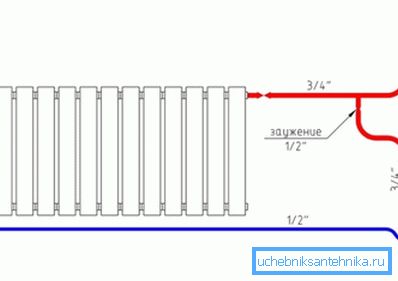
Both systems consist of the following elements:
- radiators that have a vent valve at the top and a plug at the bottom. In the lower connection mode, the latter is installed on top;
- radiator passage plug;
- thermostat and valve for 2-pipe system;
- shank;
- stopcock;
- lock nuts with which the coupling and the registers are fixed;
- bypass for 2-pipe system;
- pipelines from polypropylene, polyethylene, metalplastic or metal.
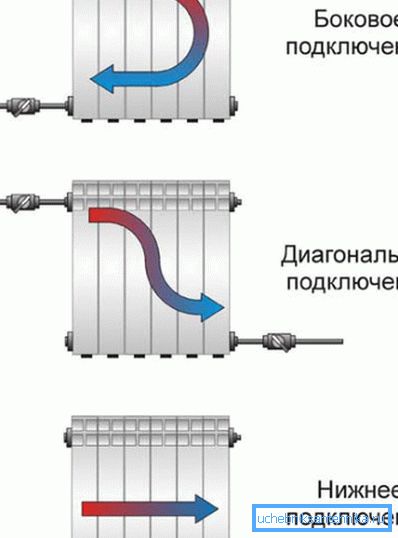
Ways to connect radiators
There are 3 main types of connection:
- Side unilateral is considered the most acceptable. The flow is made in the upper tube, the return is connected to the bottom. The method is able to give maximum heat transfer, which provides the greatest efficiency.
Tip: do not connect the bottom supply, in this case the loss of system power will be about 8%.
- Diagonal is sometimes used in batteries with a sufficiently large length. In this case, warming up occurs uniformly in all sections of the equipment, without creating temperature differences, which affects their efficiency. The supply is connected to the upper through-stopper on one side of the product, the return to the lower one on the other.
Tip: do not bring the hot coolant from below, in this case, the heating system will lose up to 10% of power.
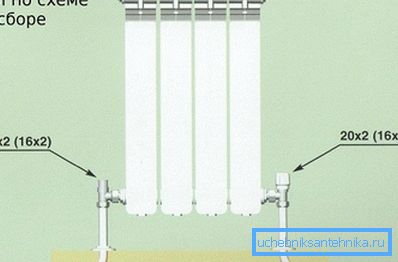
- The bottom is recommended to use only when installing pipes in the floor. In this case, the loss of power will also be up to 10%.
Tip: install radiators under the windows, not on their sides. Correctly observe the distance from the wall and window sill in height and indent.
Types of radiators
When installing a new heating system, it is recommended to use new heating devices. The market today can offer several variants of registers made of aluminum, cast iron, steel, or using combinations of metals.
You only need to choose the right model, which can be:
- Steel solid and thin panel, connection to which is possible only from the bottom or side.
- Sectional lightweight aluminum or bimetallic. Such batteries are connected in all three ways for which polypropylene pipes are ideal.

We recommend replacing cast iron heavy batteries with bimetallic batteries in centrally heated apartments. They have a large heat transfer and transfer alkali better, which is added to the coolant. Aluminum or steel radiators are best suited for independent heating in an apartment and a private house, since the pressure in such systems is low.
Conclusion
In this article we set the task to tell you about the ways of tying or connecting various types of radiators to the system of central and autonomous heating. Of the three available methods - lower, diagonal and lateral, the latter is considered the most optimal.
With it, you can increase the efficiency of heating up to 8%, in the rest it falls by about 10%. The video in the article will help you find additional information on this topic.